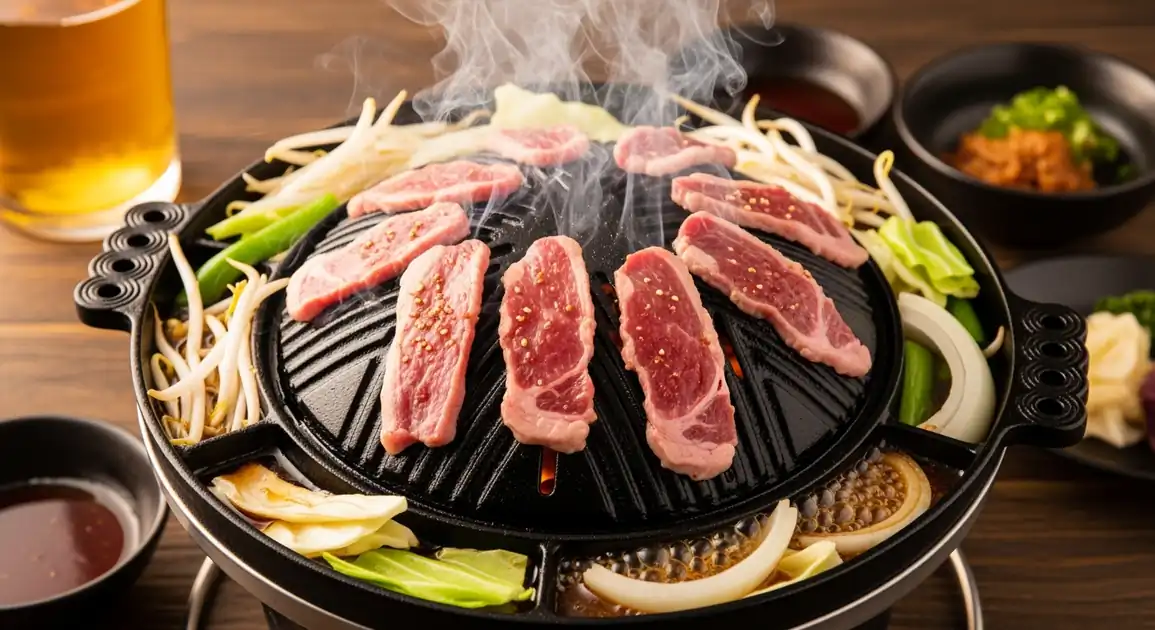Jingisukan (Genghis Khan BBQ)
ジンギスカン

Description
While Jingisukan is most famous in Hokkaido, it can be found throughout Japan, especially in major cities. Outside of Hokkaido, the dish is typically served in specialty restaurants or Hokkaido-themed establishments that aim to recreate the authentic northern experience. The preparation method, ingredients, and cooking style remain similar nationwide, though Hokkaido-raised lamb is often highlighted as a premium option.
Dietary Information
Serving information
Serving style
Typically served as a cook-it-yourself experience at the table on a specialized dome grill. The meat and vegetables arrive raw, arranged on plates, with diners cooking each portion to their preference. Accompanied by dipping sauces and often rice, soup, and pickles as side dishes.
Quick facts
Lunch: 11:30 AM - 2 PM, Dinner: 5 PM - 10 PM, with variations by establishment. Some places operate continuously throughout the day.
Safety Tips
What to Look For
-
Fresh, properly refrigerated lamb with good color and marbling
Quality lamb should have a bright pinkish-red color without strong odors. In good restaurants, you can often see the meat being stored in proper refrigerated cases.
-
Clean, well-maintained grills
The dome grill should be properly cleaned between customers. Better establishments will change or thoroughly clean the grill surface for each new group.
-
Effective ventilation systems
Good Jingisukan restaurants have proper ventilation hoods at each table to remove smoke and cooking odors, indicating they take their cooking environment seriously.
-
Staff providing cooking guidance
Quality establishments will explain the proper cooking process to first-timers, showing when to add meat and vegetables and how long to cook each item.
What to avoid
-
Eating undercooked lamb
Always ensure lamb is thoroughly cooked with no pink/red parts visible. Undercooked lamb can contain harmful bacteria.
-
Cross-contamination between raw and cooked meat
Don't use the same tongs/chopsticks for raw and cooked meat. Most good restaurants provide separate utensils for handling raw ingredients.
-
Overcrowded grills
Placing too much meat or vegetables on the grill at once can lead to improper cooking. Cook in batches for better results and safety.
-
Restaurants with very low prices compared to the area average
Unusually cheap Jingisukan might indicate lower quality meat or poor storage practices. Quality lamb has a certain cost baseline in Japan.
Price information
Price range
Budget tips
- Lunch sets are generally 30-40% cheaper than dinner, typically ranging from 2000-3000 JPY per person.
- All-you-can-eat (tabehōdai) options usually provide better value for big eaters, ranging from 3000-5000 JPY depending on time limit and meat quality.
- Beer gardens in summer often offer set menus with Jingisukan and unlimited beer for around 4000-5000 JPY.
- Larger groups can often order platters designed for sharing, which tend to be more economical per person.
Value indicators
- Establishments listing the lamb's origin (especially Hokkaido-raised lamb).
- Proper dome-shaped grills at each table rather than generic flat grills.
- Free refills of vegetables or cabbage.
- House-made original dipping sauces rather than commercial brands.
- Sets including rice, soup, and pickles in addition to the main Jingisukan.
Where to Find This Dish
Tourist Areas
Popular tourist districts in major cities often have at least one Hokkaido-themed restaurant featuring Jingisukan.
Department store restaurant floors, Major train station dining areas
Dinner, Weekends
Izakaya Districts
Areas with concentrations of Japanese pubs sometimes include Jingisukan specialty shops.
Entertainment districts, Areas with multiple restaurants
Evening, Late Night
Vendor Tips
- Restaurants with Hokkaido-themed decorations or histories often provide more authentic experiences.
- Look for the distinctive dome grills visible from the entrance or pictured in displays.
- Restaurants affiliated with Hokkaido companies (especially Sapporo Beer) often maintain good standards.
How to Order
Regional Variations
-
Marinated Jingisukan
(味付けジンギスカン (Ajitsuke Jingisukan))
The most common version featuring lamb pre-marinated in a sweet-savory sauce typically containing soy sauce, sake, ginger, garlic, apple or pear juice, and other seasonings. This style is especially popular in Sapporo.
-
Plain Jingisukan
(無味付けジンギスカン (Muajitsuke Jingisukan))
Non-marinated lamb that allows diners to enjoy the natural flavor of the meat, typically served with more robust dipping sauces on the side. Preferred by purists who appreciate the natural lamb taste.
-
Deluxe/Premium Cuts Jingisukan
(上質ジンギスカン (Jōshitsu Jingisukan))
Features higher-grade lamb cuts, often including more tender portions like rib meat or leg of lamb sliced paper-thin. Some specialty restaurants offer various grades of lamb from different producers.
-
Hokkaido Lamb Jingisukan
(北海道産ラムのジンギスカン (Hokkaidō-san Ramu no Jingisukan))
Specifically featuring locally raised Hokkaido lamb, which is renowned for its superior quality and flavor. Often prominently advertised when available as it commands premium prices.
-
Vegetable-focused Jingisukan
(野菜たっぷりジンギスカン (Yasai Tappuri Jingisukan))
A version featuring an abundant variety of vegetables beyond the standard offerings, sometimes including mushrooms, peppers, corn, and seasonal Hokkaido produce.
Cultural context
History
Despite its name suggesting Mongolian origins, Jingisukan is a Japanese creation that gained popularity in Hokkaido during the early 20th century. When Japan developed Hokkaido as a frontier, sheep were imported for wool production, and lamb consumption was promoted to utilize the meat. The dome-shaped grill was designed in the 1930s by a Sapporo engineering company, rumored to be inspired by the shape of Mongolian warriors' helmets (hence the name 'Genghis Khan'). The dish gained widespread popularity after WWII and became firmly established as Hokkaido's signature food, particularly associated with Sapporo Beer, which promoted it at their beer gardens.
Local significance
Jingisukan represents Hokkaido's distinct culinary heritage within Japan. Its popularity nationwide symbolizes Hokkaido's reputation for quality lamb and dairy products, setting it apart from traditional Japanese cuisine.
Eating customs
- Each person typically cooks their own portions on a shared grill.
- It's customary to start with just a few pieces rather than crowding the grill.
- In many establishments, it's acceptable to request additional vegetables at no extra charge.
- The meat is typically dipped in sauce after cooking, not before.